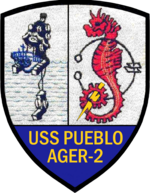
Back يو إس إس بويبلو Arabic USS Pueblo (AGER-2) German USS Pueblo (AGER-2) Greek US Pueblo (AGER-2) Esperanto USS Pueblo (AGER-2) Spanish یواساس پوبلو (ایجیئیآر-۲) Persian USS Pueblo (AGER-2) Finnish USS Pueblo (AGER-2) French פרשת פואבלו HE USS Pueblo (AGER-2) ID
 Pueblo in North Korea, 2012
| |
| History | |
|---|---|
| Name | Pueblo |
| Namesake | Pueblo, Colorado and Pueblo County, Colorado |
| Builder | Kewaunee Shipbuilding and Engineering |
| Laid down | 1944 |
| Launched | 16 April 1944 |
| Commissioned | 7 April 1945 |
| In service | 1945 |
| Reclassified |
|
| Honors and awards |
|
| Captured | 23 January 1968 |
| Fate | Captured by North Korea; 39°02′26″N 125°44′23″E / 39.04051°N 125.73974°E |
| Status | Active, in commission (held by North Korea as a museum ship) |
| Badge |  |
| General characteristics | |
| Class and type |
|
| Type |
|
| Tonnage | 345 tons dwt |
| Displacement | 550 tons light, 895 tons full |
| Length | 177 ft (54 m) |
| Beam | 32 ft (9.8 m) |
| Draft | 9 ft (2.7 m) |
| Propulsion | two 500hp GM Cleveland Division 6-278A 6-cyl V6 Diesel engines |
| Speed | 12.7 knots (23.5 km/h; 14.6 mph) |
| Complement | 6 officers, 70 men |
| Armament | 2 × M2 Browning .50 cal. (12.7×99 mm) machine guns |
USS Pueblo (AGER-2) is a Banner-class environmental research ship, placed into service during World War II, then converted to a spy ship in 1967 by the United States Navy. She gathered intelligence and oceanographic information, monitoring electronic and radio signals from North Korea. On 23 January 1968, the ship was attacked and captured by a North Korean vessel, in what became known as the "Pueblo incident",[1] or alternatively, as the "Pueblo crisis".
The seizure of the U.S. Navy ship and her 83 crew members, one of whom was killed in the attack, came less than a week after President Lyndon B. Johnson's State of the Union address to the United States Congress, a week before the start of the Tet Offensive in South Vietnam during the Vietnam War and three days after 31 men of North Korea's KPA Unit 124 had crossed the Korean Demilitarized Zone (DMZ) and killed 26 South Koreans and 4 Americans in an attempt to attack the South Korean Blue House (executive mansion) in the capital Seoul. The taking of Pueblo and the abuse and torture of her crew during the next eleven months became a major Cold War incident, raising tensions between western and eastern powers.
North Korea stated that Pueblo deliberately entered their territorial waters 7.6 nautical miles (14 km) away from Ryo Island, and that the logbook shows that they intruded several times.[2] However, the United States maintained that the vessel was in international waters at the time of the incident and that any purported evidence supplied by North Korea to support its statements was fabricated.[3] Pueblo remains held in North Korea, officially a commissioned vessel of the United States Navy.[4]
Since early 2013, the ship has been moored along the Pothonggang Canal in Pyongyang and is displayed there as a museum ship at the Victorious War Museum.[5] Pueblo is the only ship of the U.S. Navy still on the commissioned roster and held captive.[6]
- ^ "Reactions to Pueblo Incident (1968)". Texas Archive of the Moving Image. Retrieved 5 November 2019.
- ^ "Pueblo Incident". "Naenara" News from South Korea. Archived from the original on 27 May 2015.
- ^ Schindler, John R. "A Dangerous Business: The U.S. Navy and National Reconnaissance During the Cold War" (PDF). p. 9. Archived from the original (PDF) on 25 February 2013. Retrieved 24 June 2013.
- ^ "USS Pueblo – AGER-2". Naval Vessel Register. Retrieved 11 June 2009.
- ^ MacClintock, R. "USS Pueblo Today". USS Pueblo Veteran's Association. Archived from the original on 29 January 2013. Retrieved 25 January 2013.
- ^ "Ships By Fleet and Status". Naval Vessel Register. NAVSEA Shipbuilding Support Office. Retrieved 8 March 2022.